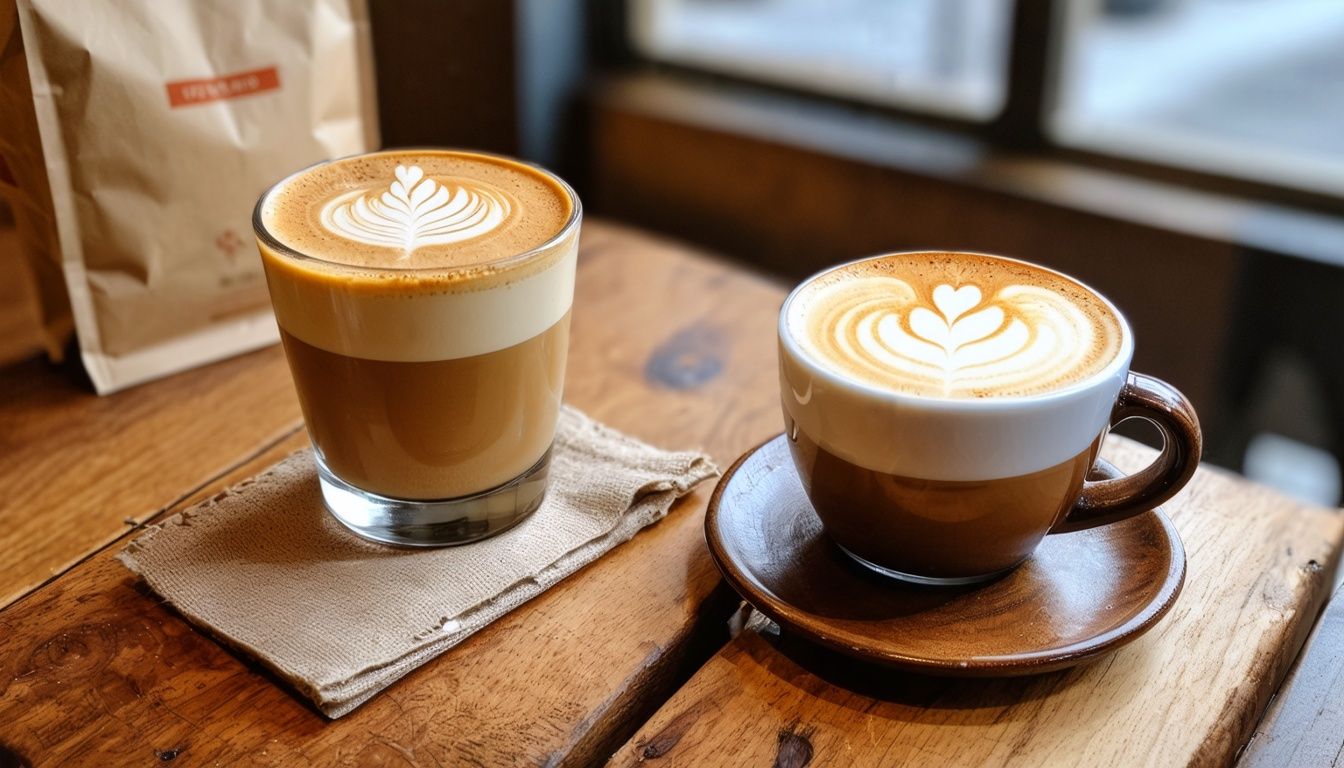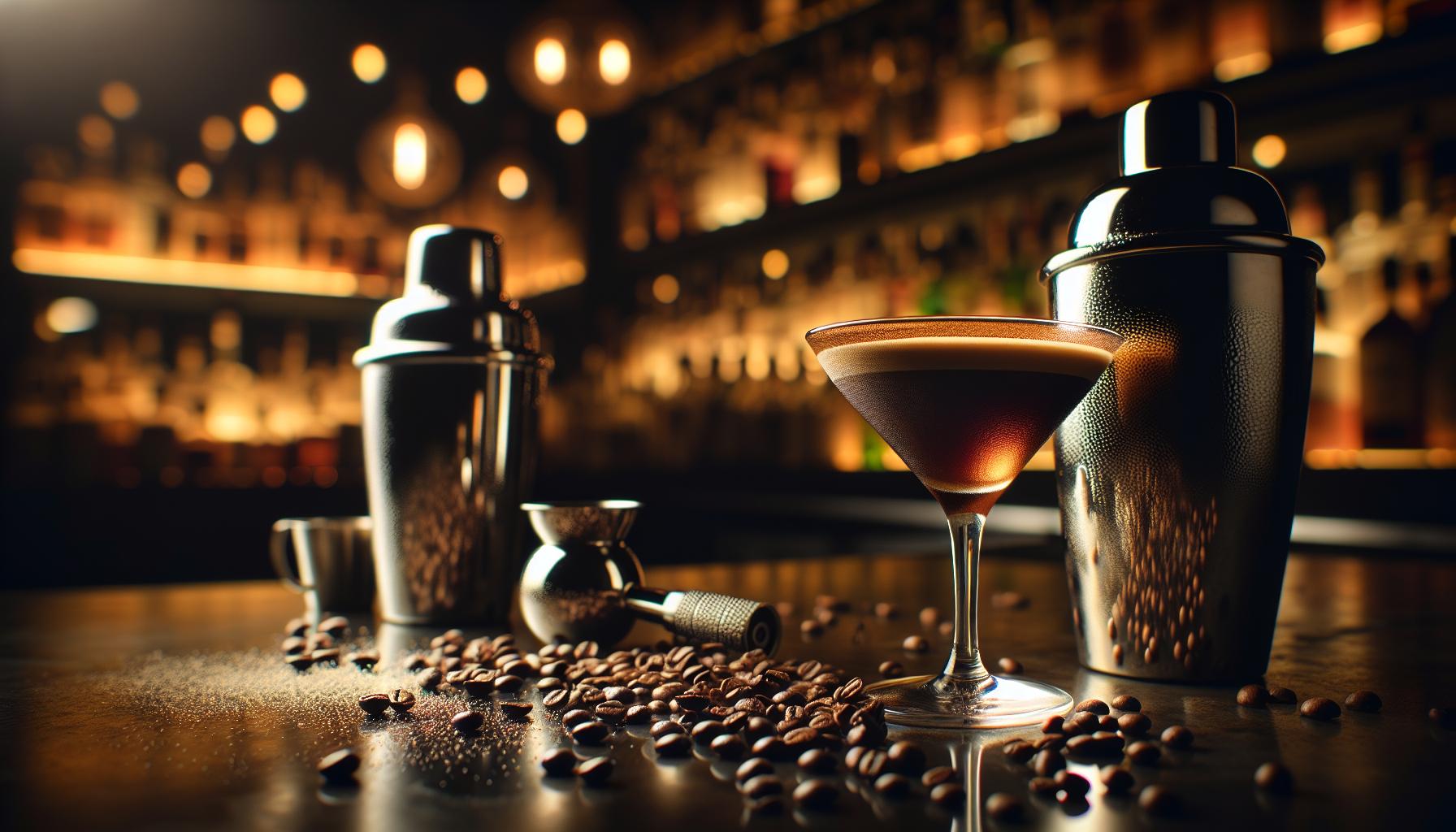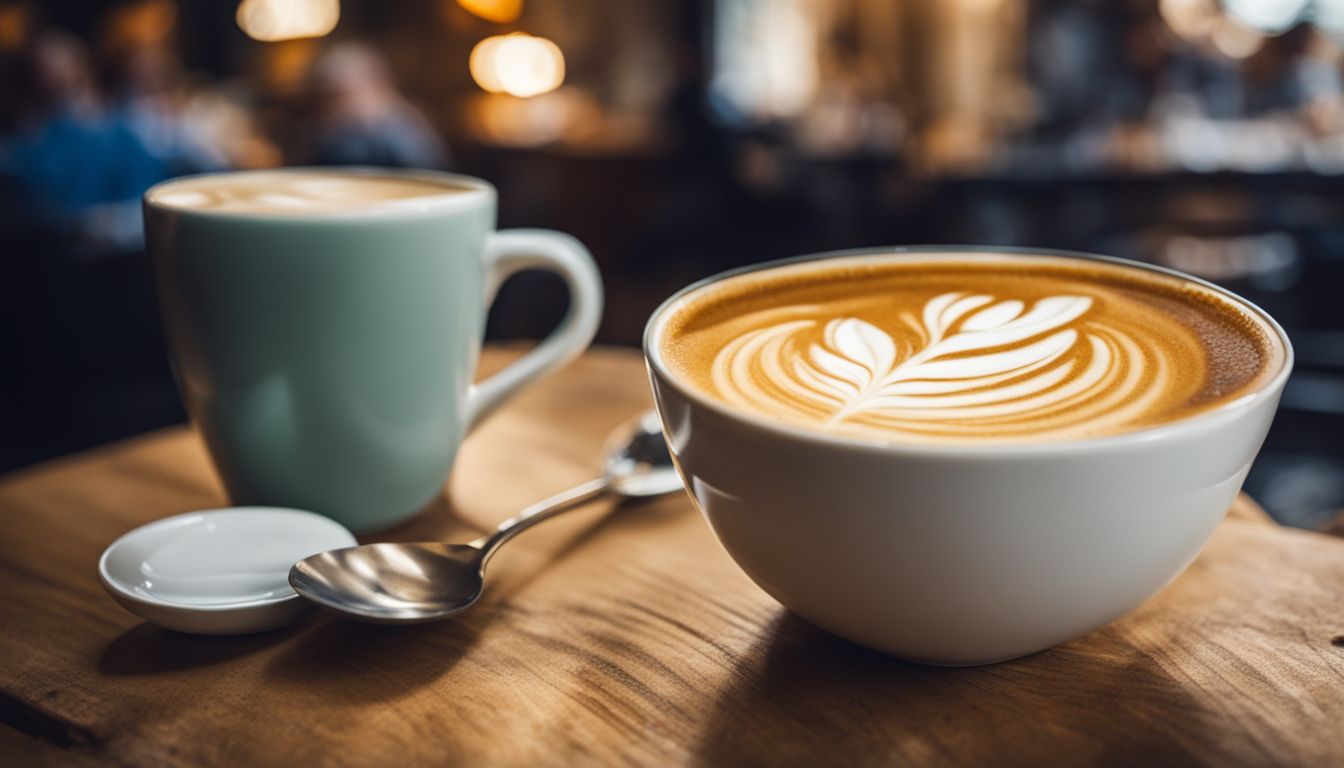Blog, Spill The Beans
Piccolo Latte Vs Cortado
Are you puzzled by the difference between a piccolo latte and a cortado? Many coffee lovers struggle to distinguish these two popular espresso-based drinks.
Piccolo latte hails from Italy, while cortado originates from Spain. Both offer unique flavour profiles and serving styles. This guide will help you understand their key differences, ingredients, and preparation methods.
You’ll soon be ordering like a pro.
The Origins and History of Piccolo Latte and Cortado

Piccolo Latte emerged in Sydney, Australia, in the early 2000s. Baristas created this espresso-based drink to offer a stronger coffee experience in a smaller serving. It quickly gained popularity among coffee enthusiasts seeking a balanced flavour profile.
The Piccolo Latte combines a ristretto shot with steamed milk, typically served in a 3-4 oz glass.
Cortado originated in Spain’s Basque Country during the 1960s. Its name derives from the Spanish word “cortar,” meaning “to cut,” referring to how the milk cuts through the espresso’s intensity.
Cortado spread throughout Spain and Latin America before reaching global popularity. This beverage balances equal parts espresso and steamed milk, usually served in a 4-5 oz cup or glass, offering a unique taste with intense coffee notes and a hint of sweetness.
Key Ingredients of Piccolo Latte and Cortado
Piccolo latte and cortado share core ingredients but differ in proportions. Here’s a breakdown of their key components:
- Espresso: Both drinks use espresso as their base. Piccolo latte uses 1 shot (30ml), while cortado uses 2 shots (60ml).
- Steamed milk: Piccolo latte has a 1:3 milk-to-coffee ratio. Cortado maintains a 1:2 ratio, resulting in a stronger coffee flavour.
- Microfoam: Both drinks feature a thin layer of velvety microfoam, created by steaming milk to 60-65°C.
- Coffee beans: High-quality, freshly roasted beans are crucial for optimal flavour in both drinks.
- Water: Filtered water ensures the best taste and protects the espresso machine from mineral build-up.
- Cup size: Piccolo latte is served in a 100ml glass, while cortado typically comes in a 150-180ml ceramic cup.
How to Prepare Piccolo Latte and Cortado
Preparing a piccolo latte or cortado requires precision and attention to detail. Here’s how you can craft these delightful espresso-based drinks:
- Pull a single shot of espresso (20-30 seconds) for piccolo latte, or a double shot for cortado
- Steam milk to 60°C, creating minimal foam for both drinks
- Pour steamed milk onto espresso at a slight angle, aiming for a 1:2 ratio of espresso to milk
- Serve piccolo latte in a 90ml glass, cortado in a 120ml glass
- Use high-quality, freshly roasted coffee beans for optimal flavour
- Grind beans just before brewing to preserve aroma and taste
- Preheat cups to maintain ideal serving temperature
- Experiment with milk alternatives like oat or almond for varied flavour profiles
- Practice latte art techniques for an appealing presentation
- Clean your espresso machine and grinder regularly for consistent results
Comparing Taste Profiles: Piccolo Latte Vs Cortado
Piccolo Latte and Cortado offer distinct taste experiences for coffee enthusiasts. Here’s a comparison of their taste profiles:
| Aspect | Piccolo Latte | Cortado |
|---|---|---|
| Flavour Intensity | Milder, sweeter | Stronger, bolder |
| Coffee-to-Milk Ratio | Higher milk content | Equal parts espresso and milk |
| Mouthfeel | Creamy, velvety | Dense, creamy foam |
| Aftertaste | Smooth, lingering milk notes | Rich coffee finish |
| Suitable for | Those who prefer a gentler coffee experience | Espresso aficionados seeking a balanced drink |
You’ll notice the Piccolo Latte’s smoother taste. Its higher milk content creates a sweeter, more approachable beverage. The creamy texture coats your palate, leaving a pleasant aftertaste.
Cortado packs a stronger punch. The equal parts espresso and milk result in a bolder flavour. You’ll taste the coffee’s nuances more clearly. The dense foam adds a luxurious touch to each sip.
Choose Piccolo Latte for a gentler start to your day. Opt for Cortado when you crave a more intense coffee experience. Both drinks offer unique taste profiles to suit different preferences.
Serving Piccolo Latte and Cortado: Sizes and Styles
Piccolo Lattes come in 3-4 oz (85-114 ml) glasses, perfect for a quick coffee fix. You’ll enjoy the creamy, velvety mouthfeel in a small glass or demitasse. Cortados are served slightly larger, in 4-5 oz (113-142 ml) cups or glasses with a hint of foam.
Both drinks offer intense coffee notes, but Cortados add a touch of sweetness. You’ll find these espresso-based drinks in specialty cafes and coffee shops across the UK. Their compact sizes make them ideal for a mid-morning boost or an after-lunch treat.
Enhancing Your Coffee Experience with Piccolo Latte and Cortado
Piccolo lattes and cortados offer a world of flavour to explore. Try different milk types, adjust sweetness, or pair with complementary treats. Read on for more ways to boost your coffee game.
Choose the Right Milk Alternative
Selecting the right milk alternative can transform your piccolo latte or cortado experience. Almond milk offers a nutty flavour, while soy milk provides a creamy texture. Oat milk, a barista favourite, froths well and complements coffee’s natural sweetness.
Coconut milk adds a tropical twist, and half-and-half delivers a rich, indulgent taste.
Your dietary needs and taste preferences guide your choice. Lactose-intolerant? Try oat or almond milk. Watching calories? Opt for unsweetened almond milk. Each alternative impacts the drink’s flavour profile differently.
Experiment with various options to find your perfect match.
Tips for Customising Your Coffee
Personalising your coffee experience opens up a world of flavour possibilities. Try these tips to create your perfect cup:
- Adjust the espresso-to-milk ratio for stronger or milder taste
- Experiment with plant-based milks like almond, soy, or oat for unique flavours
- Request an extra shot of espresso to amp up the caffeine kick
- Customise foam levels by asking for more or less steamed milk
- Add flavoured syrups or spices such as cinnamon or nutmeg for extra depth
- Try different espresso beans to explore varied taste profiles
Explore Similar Coffee Varieties
Craving variety? Try a ristretto—a concentrated espresso shot with less water. Or sample a lungo, which uses more water for a milder taste. For milk lovers, the flat white offers a velvety texture similar to the piccolo latte.
The Gibraltar, popular in San Francisco, closely resembles the cortado but comes in a specific glass.
Expand your palate with regional specialties. In Australia, sip on a ‘magic’—a double ristretto with steamed milk. In Vienna, savour a ‘melange’—similar to a cappuccino but with milder coffee.
These alternatives let you explore global coffee cultures without leaving your local café.
The Global Popularity and Accessibility of Piccolo Latte and Cortado

Piccolo latte and cortado have gained significant traction in specialty coffee shops worldwide. You’ll find these drinks in major cities across Europe, Australia, and parts of Asia.
Starbucks’ introduction of the flat white – similar to these beverages – has boosted their popularity. However, accessibility varies; piccolo lattes are harder to find in some countries, often misunderstood or confused with cortados.
Cortados enjoy wider recognition, available in many cafés globally. They pack double the espresso of a piccolo, appealing to those seeking a stronger coffee hit. In contrast, piccolo lattes have found a niche following in certain Asian markets.
Your local coffee scene might offer these drinks under different names, so ask your barista about small, milk-based espresso beverages to explore these flavours.
Answering Common Queries on Piccolo Latte and Cortado

Common questions about piccolo latte and cortado often arise among coffee enthusiasts. Here’s a list addressing the most frequent queries:
- Composition: Piccolo latte contains 20-30 ml espresso and 40-60 ml steamed milk. Cortado has equal parts espresso and steamed milk.
- Size: Piccolo latte is served in a 3-4 oz (85-114 ml) glass. Cortado is typically served in a 4-5 oz (118-148 ml) glass.
- Milk texture: Piccolo latte features a small amount of microfoam. Cortado has lightly steamed milk with minimal foam.
- Flavour profile: Piccolo latte offers a more pronounced espresso flavour than a standard latte. Cortado balances espresso and milk equally.
- Origin: Piccolo latte originated in Australia. Cortado hails from Spain.
- Availability: Piccolo latte can be hard to find on menus due to consumer confusion. Cortado is more widely available in coffee shops.
- Best coffee beans: Saša Šestić recommends coffee with chocolate, hazelnut, or caramel notes for piccolo latte. Cortado pairs well with medium to dark roasts.
- Caffeine content: Both drinks contain similar caffeine levels, typically one shot of espresso.
- Milk alternatives: Both can be made with non-dairy milk options like soy, almond, or oat milk.
- Serving temperature: Both are served hot, but iced versions are becoming popular in some cafes.
Conclusion

Piccolo Latte and Cortado offer unique coffee experiences. You’ll savour a sweeter, creamier taste with Piccolo Latte. Cortado delivers a bolder espresso flavour with balanced milk.
Both drinks adapt well to milk alternatives, expanding your options. Experiment with different beans and roasts to find your perfect cup. Your local café likely serves these European-inspired beverages.
Enjoy exploring these rich coffee traditions at home or out.
FAQs
What’s the difference between a piccolo latte and a cortado?
A piccolo latte is an Aussie coffee drink with a shot of espresso and steamed milk. A cortado is Spanish, with equal parts espresso and warm milk. Both use microfoam for a velvety texture.
How much caffeine is in each drink?
Both contain one espresso shot. Caffeine content depends on the coffee beans and roast. Typically, it’s about 60-80mg per shot. Decaf options are available for those watching their intake.
Can I make these drinks at home?
Yes! You’ll need an espresso machine or moka pot, coffee grinder, and milk frother. Grind fresh beans, pull a shot, steam milk, and combine. Practice makes perfect for that coffeehouse taste.
Are piccolo lattes and cortados served in special cups?
Piccolo lattes come in small glasses, about 100ml. Cortados are served in 150-200ml cups. Some cafes use traditional Spanish glass tumblers called ‘Gibraltar’ for cortados.
How do these compare to other espresso drinks?
They’re smaller than lattes or flat whites, with less milk than cappuccinos. More milk than macchiatos. They’re perfect for those who want a strong coffee taste with a bit of creamy texture.
Can I use alternative milks in these drinks?
Absolutely! Soy, almond, oat, or any other alternative milk works. Each will affect the flavour and foam differently. Experiment to find your favourite combination.


